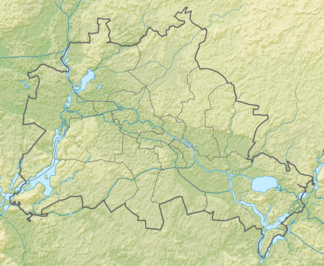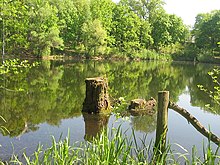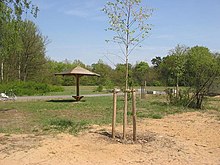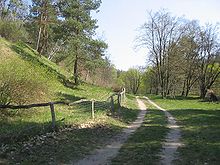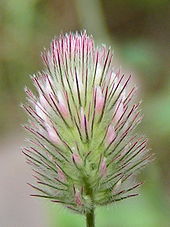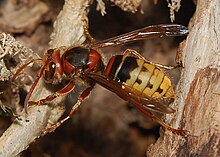Murellenberge, Murellenschlucht and Schanzenwald
| Murellenberge, Murellenschlucht and Schanzenwald | ||
|---|---|---|
|
Murellenberg and Schanzenwald |
||
| Highest peak | Murellenberg ( 62 m above sea level ) | |
| location | Location Ruhleben , Berlin-Westend , Germany | |
|
|
||
| Coordinates | 52 ° 31 ' N , 13 ° 13' E | |
| Type | Terminal moraine , compression moraine , dry valley | |
| rock | Debris , gravel , sand , boulder clay | |
| Age of the rock | approx. 20,000 years, Vistula Ice Age | |
| particularities | As Murellenschlucht and Schanzenwald nature reserve since 1993 (No. 18); Memory of executions by the NS -Militärjustiz as area memorial memorials . Part of the Teltownordband , western flat areas belong to the Berlin glacial valley . |
|
|
Map of the hills and the Olympic site |
||
The Murellenberge that Murellenschlucht and the Schanze forest are in the Weichseleiszeit resulting hills in the Berlin local situation Ruhleben in the district Westend the district Charlottenburg-Wilmersdorf . The area is located west of the Olympic site . The largest part of the compression and terminal moraine landscape is designated as the Murellenschlucht and Schanzenwald nature reserve, which is part of the Fließwiese Ruhleben , Tiefwerder Wiesen and Grunewald biotope network . About 1 1 ⁄ 2 kilometers northeast of the area (from Murellenberg) is the natural monument Murellenteich .
The Murellenberge (often referred to as 'Murellenberg', formerly: Morellenberge ) are part of the Teltownordband, which forms the northernmost branch of the Teltow plateau to the Berlin glacial valley . The relationship of the original natural environment went through the city building largely lost. The up to 62 meter high mountains and the up to 30 meter incised valley basin have diverse and threatened flora and fauna , especially in their dry grass areas . Used as a military and police area for over 150 years, the forest in the Schanzenwald was able to develop almost undisturbed. In the eastern part of the gorge, the Waldbühne was built in 1936 under the direction of the architect Werner March . The National Socialists set up a place of execution in the mountains for deserters and so-called " military force disintegrators ". The installation Denkzeichen in memory of those murdered by the Nazi military justice on Murellenberg by the artist Patricia Pisani from 2002 commemorates the victims.
Location of the area and etymology
The originally much more extensive and now partially sprawled hilly area extends to the mouth of the Spree and the Havel . In addition to the current nature reserve, it includes a police training area and the Ruhleben cemetery to the north . The part of the Schanzenwald west of the police area, which was long used for military purposes, is now largely accessible again and part of the nature reserve. The Spandau suburban railway embankment, which was built in 1907, limits the area to the west . The railway line also forms the border between the districts of Charlottenburg-Wilmersdorf and Spandau . To the south and east, the Murellenschlucht gorge and its continuation in the flow meadow Ruhleben complete the area today, in simplified form. In the north, the Hempelsteig delimits the area, the course of which roughly follows the formerly area-dividing and filled-in Elsgraben.
The name component Murellen or earlier Morellen is traced back from the Brandenburg name book to the Morelle (= sour cherry ). In a lexicon of Berlin's street names there is also the entry under Murellenweg , which leads from the flow meadow Ruhleben to the Ruhleben settlement: “Murelles, overgrown cherries that gave the Murellenberg their name.” A derivation from moraine (from French moraine , rubble ' ), which highlights the geological structure of the area, cannot be verified.
Geology and climate
North band of the Teltow
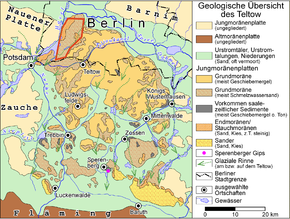
Geologically , the Murellenberge as well as the Grunewald belong to the Teltow plateau, which runs out to the west in the Havel lowlands and to the north in the Berlin glacial valley, through which the Spree flows. The Havel separates the Weichsel Ice Age Teltow plateau from the northwestern Nauener Platte with Gatow and parts of Wilhelmstadt . The Spree valley separates the plateau from the Barnim . While the basement moraine plate of the Teltow is largely flat and undulating and is determined by glacial till, exceptionally thick (20 meters and more) meltwater sands from the advancing phase of the inland ice dominate the Grunewald . In the area around Schildhorn , the Pichelsberg and the Murellenberg mountains, the advancing ice has also strongly compressed (disturbed) the sands, so that a moving relief of a compression / terminal moraine defines the landscape. The northern edge of the Teltow runs from the Murellen Mountains along the Murellen Gorge further north and turns to the northeast shortly after reaching the Ruhleben flow meadow. It leads around the Murellenteich and further over the former Spandauer Spitze at the former Spandauer Bock and the Ruhwaldpark to the steep slope above the mineral water spring Fürstenbrunn. At this point, south of today's Rohrdammbrücke , the Teltow plateau reaches its northernmost point. Then the Teltowkante bends to the southeast along the Charlottenburg Palace Gardens .
Today's Murellenschlucht dry valley is a former dead ice channel that cuts up to 30 meters deep into the hilly landscape. The gorge, which is up to 100 meters wide, runs along the southern edge of the entire area and separates the Murellenberge from the Pichelsberg, which, like the Murellenberge, is 62 meters high and is now almost completely built over. To the west, the drainage channel originally extended over the Havelaltarm Hohler Weg to the Stößensee . In the other direction, it turns north and continues in the silting moor and nature conservation and Natura 2000 area Fließwiese Ruhleben. The north-western Schanzenwald already belongs to the valley sand area of the Spree lowlands in the glacial valley. (For the entire northern band of the Teltow and its location in relation to the Spreeniederung → see historical map .)
Boulders
Numerous erratic boulders testify to the power of the ice in the Murellenberg Mountains . Two of the erratic blocks are protected as natural monuments (NDM): one is located in the Murellenschlucht (NDM VII-6F), the other (NDM VII-5F) was moved from the Murellenschlucht to the meadow at the southern exit of the elevated underground station in 1968 Brought calm life. While the boulders in the gorge and the mountains are otherwise mainly made of granite , the stone at the train station is made up of gray, medium-grain sandstone (so-called brown coal quartzite). Since debris made from this soft material is usually no more than head size after drifting from Scandinavia , the 1.2 m³ large boulder cannot have traveled that far, unlike granite or gneiss boulders. Experts therefore suspect the region around Stettin or Bad Freienwalde as the place of origin. Its dimensions are 1 m × 1 m × 1.2 m and that of the boulder in the canyon, which is probably made of biotite gneiss or alkali granite , 1.5 m × 1.5 m × 1 m.
climate
The Murellenberge and the Schanzenwald are located in a moderate climate zone in the transition area from the Atlantic climate of Northern / Western Europe to the continental climate of Eastern Europe. The climate corresponds to that of the Berlin outskirts. Parts of the Murellenschlucht, which is said to have been called the Kuhle Grund , belong to one of the inner-city “cold islands”.
See also: Climate section in the Berlin article
Natural development and urban interventions
As a result of increasing development, the landscape of the Murellenberge, which was shaped by the Ice Age, has lost its connection to the surrounding parts of the landscape and "has lost its original character in many areas."
Lost connection to the Grunewald (south)
The northern border of the forest and landscape area Grunewald is now usually drawn with the Heerstraße , so that the Murellenberge lying north of the road are spared from Grunewald. In the past the mountains, the gorge and the Schanzenwald belonged to the forest or to the Teltower Heide and Spandower Heide , as the Grunewald was previously called. The Prussian map of 1835 describes the Murellenschlucht as a valley within the Spandau Heath. The separation of the Murellenberge from today's Grunewald landscape began in 1907 with the construction of the Grunewald racecourse and the German stadium on the former Grunewald site and the simultaneous construction of the Heerstraße and the Spandau suburban railway , which cut through the extensive natural area of the Grunewald from west to east. Further buildings for the 1936 Olympic Games , especially in the area of the Bell Tower , narrowed the forest connection. With the construction of the high-rise estate on Angerburger Allee in the 1960s, the direct green connection between the Murellenberge / Schanzenwald area and the Grunewald was finally lost. In terms of forestry , however, the area is still assigned to the Grunewald, as it belongs to the Saubucht district forester.
In the course of the construction work for the 1936 Summer Games, the Waldbühne , an open-air stage with space for 22,000 spectators , was built in the eastern part of the Murellenschlucht under the direction of Werner March and according to plans by Conrad Heidenreich . The construction in the form of a natural basin meant a considerable encroachment on the natural environment, even if the natural slopes of the Murellenberge were largely retained. The southern embankment and parts of the gorge were also filled with rubble between 1948 and 1950. Today the new ice rink and the central building of the Gasag natural gas storage facility in Berlin stand on the embankment .
Separation from Tiefwerder (west)
West of the area close Tiefwerder and the conservation area Tiefwerder meadows on, one of Berlin's last flood and spawning areas for pike . The nature reserve, traversed by arms of the Havel, extends 100 meters to the Murellenberge / Schanzenwald area, but the Havelchaussee and the embankment represent a natural barrier between the areas. The construction of the Havelchaussee between 1876 and 1885 as a forest and connecting path from the community of Zehlendorf to Spandau brought the first major cut into the western natural area of the area. The Chaussee was built in this area parallel to the old post route. Between the Postweg and the Chaussee, the final separating embankment of the Spandau suburban railway , also known as the “Olympiabahn”, was raised in 1907 . The construction of today's S-Bahn took place in the course of preparations for the Summer Olympics , which were planned for 1916, were canceled because of the First World War and only took place 20 years later in Berlin. The Alte Postweg has been running east next to the S-Bahn route since then and is now the westernmost hiking trail in the Schanzenwald.
Former northern boundary Elsgraben
Interventions in the northern area of the Schanzenwald already took place in 1840 with the construction of barracks, shooting ranges and the namesake jumps. After the Second World War , the British occupying forces used the site as a military training area. Since 2007 it has been open to the public again as a reclaimed recreational area. Part of it was incorporated into the NSG Murellenschlucht and Schanzenwald . (→ see chapter "Schanzenwald" .) To the north-east of the former military area there is a practice area that is still used by the police today, followed to the north by the Ruhleben cemetery, which was laid out in 1952 . "The concept of an 'open cemetery' integrated in the surrounding area was not implemented."
Even before the barracks and entrenchments were built, the Elsgraben was built from 1832 on, which formed the northern boundary of the hilly terrain for a century. The moat connected the (old) Spree across from what was then Otternbucht (roughly at the height of today's Reuter thermal power station ) with the Faulen See in Tiefwerder, which in turn is connected to the Havel via several Havel arms and the Stößensee - still today. The ditch, which was navigable until 1886, was intended to protect Spandau during floods by directing the water to the Havel before the city. In addition, it should drain the surrounding areas and improve agricultural use. In collaboration with Borsig , Friedrich Neuhaus had the first German wrought iron lattice bridge built over the Elsgraben. With the canalization of the Unterspree in the 1880s, the Elsgraben lost its importance and was gradually filled in until around 1930. Its course is roughly followed today by the Hempelsteig and Elsgrabenweg in the Spandau part of Ruhleben, which is the last memory of the Graben in the Berlin cityscape.
The construction of the Elsgraben had a considerable influence on the water balance of the Murellenberge and Murellenschlucht. In particular, the region drained into the ditch via the Ruhleben flow meadow, with the result that the water level of the silting bog fell. Drainage has been interrupted since the Hempelsteig was filled in in 1936 when the forest stage was excavated .
Integration of the natural monument Murellenteich (northeast)
The northern band of the Teltowkante reaches the Murellenteich around 1 1 ⁄ 2 kilometers northeast of the Murellenschlucht and 700 meters east of the flow meadow Ruhleben. In the lowlands below the edge of the plateau, the Ruhleben settlement with one and two-story houses was built in the 1920s on the site of a former shooting range . To the south of it on the plateau, the German Sports Forum was built at the same time on today's Olympic site. The tree-lined depression of the Murellenteich natural monument is only connected to the Murellenberge by the narrow, wooded slope between the settlement and the sports forum. The historical map from 1842, which shows the area without any buildings, illustrates the originally contiguous natural area.
The State of Berlin assigns the natural monument to the forest area of the hilly landscape and includes it in its description of the NSG Murellenschlucht and Schanzenwald: "The extent of the structurally rich mixed deciduous forest, which extends from the Murellenteich to the west over the Murellenschlucht, the Murellenberg and the adjacent north Schanzenwald extends to the police area, which is a specialty for Berlin conditions. ”In terms of biotope and species protection , the Senate Department for Urban Development and Environmental Protection lists the pond under the heading“ Nature reserves / natural monuments with extensive characteristics ”as the type“ PfW ”. "Pf" stands for "puddles and other small bodies of water" and "W" for "types of forests (forests / forest parks within settlement areas)" The pond, which was much larger at the time, was used as a military bathing facility until 1935 and had a long bathing jetty and a Diving platform.
The Murellenteich was connected to the Spandauer Bock excursion restaurant , which developed from a small bar opened in 1840 by the brewer Conrad Bechmann, through an underpass under the Hamburg light rail connection. Opposite on the north side of the Spandauer Damm on the so-called Spandauer Spitze, there was the Bechmann Brewery, the Spandauer Berg Brewery , as well as the second part of the restaurant, popularly called after the female counterpart to the Bock Zibbe . One of the attractions of the restaurant, which was closed in the late 1930s, was the imposing view of the Spree valley. To the east, the magazine publisher Ludwig von Schaeffer-Voit had Carl Schwatlo build the so-called Schloss Ruhwald in 1867/1868 and create a spacious landscape park , today's Ruhwaldpark ; In 1952 the classicist villa was torn down.
“The steep slope of the Teltow plateau, which is otherwise kilometers away from the river bed of the Spree, comes unusually close to the river at this point. So it was possible to put the villa on the slope edge, 30 meters above the water and with a magnificent view. In 1937 it was still possible to see through the Spree and Havel valleys as far as Lake Tegel. [...] Its excellent location can no longer be experienced because all prospects have grown over. "
The closest approach to the Spree was the north edge of the Teltown another 600 meters to the northeast at a former rifle house built in 1818 to the west of today's Rohrdammbrücke . Located near the historic Fürstenbrunn mineral water spring , the Teltow hill in front was named Fürstenbrunner Höhe and later Spandauer Berg in 1879, although it is not entirely certain whether the Spandauer Berg included the area known as the Spandauer Spitze . In the course of the urban development , the Spandauer Berg was "regulated", as noted in the Lexicon of Berlin Streets.
Schanzenwald
Military and police use
The first military installations near the Murellenberge, at that time still the Spandau area, with barracks and shooting ranges, were built around 1840. In 1855 the rifle examination commission began work on the site, from which the Royal Infantry Shooting School in Ruhleben emerged. The Prussian military built during this era also ring around the Old Town Spandau and the citadel ramparts and redoubts . In the 1850s, two forward, outer and stand-alone lunettes were built on Elsgraben as part of the Stresow fortification : the Ruhleben ski jump north of the mouth of the river from the Murellenschlucht into the Elsgraben and the Teltower Schanze or Teltower Brück Schanze, which gives the forest its name, in the northwest corner of today's Schanzenwald. Both entrenchments were given a two-storey reduit , which was suitable for both rifle and gun defense. Although this method of fortification was out of date by the end of the 19th century at the latest, the Schanzenwald was used continuously for around 150 years as a military and later police training area and firing range. On the sports field Teltower Schanze (tennis court) in the corner of Havelchaussee / Elsgrabenweg there is still a listed remnant (ski jump, ditch, cavity protection room and fortification) of the Reduit building.
After the Second World War , the British allies took over the restricted area , which handed it over to the Berlin police in 1994 . After tough negotiations, the Senate Administrations for the Interior and Urban Development agreed in 2004 to transfer the area to the Berlin Forests . Only a small remaining area in the north with an ammunition depot and the so-called Fighting City , in which the British military trained house-to-house fighting , remained with the police. “The battle village was built by the British to practice house-to-house fighting. Typical urban situations are reproduced: small houses, high-rise buildings, a church, supermarket, gas station, telephone booths, a railway embankment with a few subway cars on it [...] The exercise could be monitored and controlled from a control center via video cameras and loudspeakers. " Today the police train special units such as the SEK or personal protection in the Fighting City.
Renaturation 2007, replacement measure by Deutsche Bahn
For the renaturation of the practice area, “extensive measures to secure and remove danger spots, unsealing of paths and squares, dismantling of enclosures, restoration of the landscape and the development and design of the area” were carried out. The Berlin forest administration unsealed and renatured an area of 9,400 square meters, including 6,850 square meters of pathways and squares made of asphalt, concrete and composite concrete pavement as well as 2,000 square meters of massive buildings such as wooden and metal barracks and 2,600 meters of fences, 2,000 square meters of shooting protection stands and walls and 20,800 t waste and demolition, of which 6,500 t hazardous.
The project was financed by DB ProjektBau in the amount of around 830,000 euros . The subsidiary of Deutsche Bahn had undertaken to take over as a substitute for nature conservation law for the damage to nature and the landscape caused by the construction project for the Hanover – Berlin high-speed line , planning approval section 1E. In addition, funds from the environmental relief program of the EU (2006) and the state of Berlin in the amount of around 760,000 euros and a further 56,000 euros by the Charlottenburg-Wilmersdorf district office were used for the demolition and disposal of the heavily contaminated materials.
On November 28, 2007, the district's environmental councilor opened the 38- hectare new recreational area to the public , which also received a new network of paths by 2009. The DB's replacement measures also included the opening of the Am Rupenhorn forest south of Heerstraße on Stößensee . This measure led to the extension of the Havelhöhenweg to Heerstraße and its connection to the NSG Murellenschlucht and Schanzenwald, so that the connection of the Murellenberge with the Grunewald is restored via a hiking trail.
Shooting site and memorial
In addition to the urban encroachment on the natural environment, the execution site of the Nazi military justice system shaped the history of the uninhabited Murellenberge.
Execution site of the Nazi military justice
Contrary to what is stated otherwise, the shootings very probably did not take place directly in the Murellen Gorge. After a site inspection in 1995 with contemporary witnesses and a topographical analysis, an area near today's ammunition depot or a sand pit in the Schanzenwald come into question. In the final phase of World War II that imposed central court of the army , the flying court martial of the Army and other military tribunals than 230 death sentences that the in this shooting space V Wehrmacht in Berlin site, immediately, as a rule, were carried out. The judgments, against which appeals were not permitted, were mainly aimed at German so-called Wehrkraftzersetzern and deserters of the Wehrmacht. In individual cases, Alsatians of French nationality who were forcibly recruited into the German Wehrmacht were also affected. File studies showed that these were exclusively politically motivated death sentences, as in the case of the professional officer and resistance fighter of July 20, 1944, Gustav Heisterman von Ziehlberg . According to previous analyzes, 232 people were shot here between August 12, 1944 and April 14, 1945, but the number of unreported cases is higher. The pastor of the Protestant village church Staaken spoke in a 1995 report of over 300 executions . 117 of the murdered found their final resting place in the Spandau cemetery in the Kisseln , 81 in Engelsfelde near Seeburg in graves not specially marked.
Memorial
Competition and realization
After the Berlin application for the 2000 Summer Olympics , in which the Olympic village was to be built on the grounds of the Schanzenwald, the pastor of the Charlottenburg District Synod, Manfred Engelbrecht, founded the Murellenschlucht / Olympic site working group in 1994 with the aim of creating a memorial for the victims of the To create Nazi military justice . In 1997 the working group and the Charlottenburg district assembly agreed on a design by the architect and artist Wolfgang Göschel, a member of the Wassertorplatz architects' group . The memorial made of three stylized execution stakes made of steel was intended to represent the biographies of three murdered people on behalf of all victims. The path to the Waldbühne was planned as the location. Here the memorial was supposed to correspond with the Nazi architecture of the 1936s Olympic buildings . The project failed due to lack of funds.
In 2000, the Senate Department for Urban Development then invited nine artists to a competition for the memorials in memory of those murdered by the Nazi military justice on Murellenberg . In 2001, the jury decided in favor of the design by the Argentinian artist Patricia Pisani, who lives in Berlin . Starting from the bell tower road, Patricia Pisani set up traffic mirrors along the forest path 104 , the number of which is concentrated towards the probably authentic shooting site at the ammunition depot.
“The installation of these well-known objects in road traffic arouses attention and curiosity in the unfamiliar surroundings of the forest. On a symbolic level, they refer to a danger and warn: Be careful here! Engraved texts on selected mirrors build a bridge to historical events and create references to the present. The texts are visually overlaid with reflections of the passers-by, the forest and the authentic shooting range. "
Patricia Pisani justifies her considerations on the choice of traffic mirrors as an art object, among other things, with the fact that traffic mirrors show “what is happening around the corner, a danger or a threat that may be approaching in a confusing place but cannot yet be seen. They show something that is not visible from the current location: around the corner, into the past, into the future. ”The 15 mirrors provided with laser-engraved texts refer to the history, the location, the Nazi judgments and laws, and gain access to the location The events take on an increasingly personal level with quotes from direct experiences of contemporary witnesses , including:
“A judgment was read out and broken fragments over to me. The corporal […] years old […] for deserting […] to death […], the mate […] years old […] judged […] for cowardice the enemy [...] to death by shooting [...] "
At the inauguration of the installation on May 8, 2002, Ludwig Baumann , Wehrmacht deserter and chairman of the Federal Association of Victims of Nazi Military Justice , introduced his speech with Hitler's quote : "The soldier can die, the deserter must die."
Review: Second class commemoration
In his inauguration speech for the surface memorial, Ludwig Baumann criticized the fact that it was not possible to commemorate the authentic location. Baumann pointed out that the place at the ammunition depot still belongs to the fenced-in police compound. However, the place could be seen from the memorial path, as it was in the extreme southeast corner of the exercise area close to the fence. Initiatives to make the square accessible initially failed because of the Senate Department for Home Affairs. Lothar Eberhardt, who has been accompanying the Nazi memorial work critically for years, describes the memorial as “second-class commemoration” . Instead of Wolfgang Göschel's design being implemented on the route to the Waldbühne, which is clearly visible to many, the Senate opted for memorials that are “hidden in the forest”. Regarding this criticism, it should be noted that there is another traffic mirror in the urban area at the former Imperial Court Martial and refers to the memorial on Murellenberg.
In the meantime, the entire area of the former ammunition depot up to the fence of the Fighting City has been completely cleared, renatured and opened to the public. The previously inaccessible shooting place of the Wehrmacht is therefore accessible to everyone. From the Schanzenwald over the southern part of the Große Schießwiese, the area has also been opened up by an additional path from this side.
Conservation of nature, flora and fauna
In the hilly region, steep slopes with southern exposure offer flora and fauna adapted to dry and warm conditions that have become rare habitats. 92 mainly endangered species of bees and wasps are found here. The Ruhleben flow meadow, which is designated as a separate nature reserve, is characterized by the existence of rare aquatic plants , a black alder biotope and the abundance of amphibians , including in particular the strictly protected crested newt , which made the flow meadow a Natura 2000 area.
→ Main article Flow meadow Ruhleben
Murellenschlucht and Schanzenwald nature reserve
The state of Berlin placed the core area of the area under protection on January 26, 1968 as a natural monument and on March 10, 1993 as Berlin nature reserve No. 18 under the name Murellenschlucht and Schanzenwald with 28.5 hectares . In § 3, the ordinance on the nature reserve Murellenschlucht and Schanzenwald in the Charlottenburg district of Berlin lists as protection purposes:
“The area designated in § 2 is protected to
1. the communities
- a) the Murellenschlucht as a dry, warm habitat that has become very rare in Berlin
- b) to preserve the adjacent pine and oak forest of Murellenberg and Schanzenwald;
2. to secure a permanent existence for endangered animal species and
3. to preserve the area because of its diversity and special character. "
flora
Dry sandy lawns with a mixed fringing and bush flora not only dominate the south-facing slope areas of the gorge, but also interrupt the landscape in the Murellen Mountains and the Schanzenwald, here in particular on the former Großer Schießwiese. The occurrence of the sand straw flower is remarkable . The golden or lemon-yellow flowering member of the sunflower family is considered endangered and is particularly protected according to the Federal Species Protection Ordinance (BArtSchV). Sharp stonecrop , small hawkweed , rushed cartilaginous lettuce and common piglet weed add further yellow accents. The flowers of the mountain sand bells stand out in light blue , which prefers dry, sandy grasslands or rocky areas with little lime and was voted Flower of the Year 1990 because of its endangerment . Red and pink tones complement the sorrel , hare-clover , common carnation and red ostrich as well as fescue . Sheep fescue and the pioneer plant silver grass complete the family of sweet grasses on the dry and warm locations.
The ramparts of the former shooting range structure the Schanzenwald, in which biotope qualities could develop relatively undisturbed due to the over 150 years of isolation. Pine and oak trees , some of which are 300 years old, characterize the forest and the wooded areas of the Murellenberge. Light pedunculate oaks - birch parts ensure loosening up. Also noteworthy are some very old common bird cherries and the old oak avenue of the former postal route. Robinia crown the crests of some earth walls. The age structure is very mixed and the stands are characterized by strong horizontal stratification (herb, shrub, tree layer). “This area differs significantly from the trees in the Grunewald, which were mainly afforested and which, by their nature, are so-called age class stands. The diversity of habitats for the native fauna is significantly lower there and the number of species accordingly. ”In addition, there is a high proportion of dead wood , which is of great importance for communities in the bark , in the wood , in tree hollows and in special structures such as sap rivers or burns. Many species of insects , such as ants , hymenoptera and butterflies find their habitat here . The majority of wasps and bee species are dependent on the decay and decomposition phases of old and dead wood.
fauna
Inventory studies by the Zoological Institute at the Free University of Berlin revealed that 97 different flying insect species, 57 of which are rare or endangered, and eleven rare butterfly species are native to the structurally rich biotope. In particular, Hymenoptera , which invest their nests in the ground and warm dry-on locations are instructed to find ideal conditions. These include digger wasps such as the beewolf , which catches honey bees as food for its larvae and immobilizes them with a sting with a fast-acting poison. More cuckoo wasps and also social parasites like the cuckoo bumblebee , which let other bumblebees raise their young , live in the area. There are also cuckoo bees such as wasp bees or blood bees , as well as silk bees , furrow bees and recluse bees such as cone bees . All wild bees and bumblebees are protected by the BArtSchV. From the family of aculeata There are several wasps , including the German , Saxon and common wasp and wrongly feared, specially protected by BArtSchV Hornet , which, however, not on the Berlin as endangered red list stands. Arachnids and beetles are numerous. It is noteworthy that the Brandenburg Red List lists a water beetle that is now extinct / lost and that was found at Elsgraben in 1921: the hook beetle Dryops Similaris BOLLOW , a typical river inhabitant.
The old wood stocks also use cave breeders to build their nests . A total of 65 bird species are native to the area . Songbirds dominate the forest and the occasional great spotted woodpecker can be heard. At the Murellenteich in 1999 ornithologists identified a breeding pair of the pond rail, which is on the red list in the early warning level (status: 2006). From the class of reptiles , the slow worm and the sand lizard are represented. Wild boars , roe deer , red foxes and small mammals such as the wood shrew also inhabit the Murellenberge, Murellenschlucht and the Schanzenwald.
Maintenance measures
In order to preserve the geomorphologically exceptional natural area and its biotopes, the State of Berlin carries out various maintenance measures. This includes regular mowing , removing the cuttings and keeping woody growth free to maintain the dry, warm and nutrient-poor locations. Robinia is to be pushed back in the forest, a problematic neophyte that threatens the biodiversity of biotope types such as grasslands , limestone grasslands and dry sand grasslands . The high proportion of dead wood is to be retained and the south-facing slopes are to be kept free of shady trees. Otherwise, the responsible Senate Department for Urban Development wants to leave the area to its own devices as much as possible and limit measures to traffic safety and maintenance of the road network.
Outlook: Concept of a high path on the Teltownordkante
The connection of the Murellenberge with the northern band of the Teltow is barely noticeable in today's cityscape due to the urban construction , the overbuilding with streets, railway lines, underground lines and settlements. In order to make the unity of the landscape tangible again, the Senate Department for Urban Development proposed a high-altitude path on the north edge of the Teltown in a plan in 2004 , which should connect the Murellenberge to the Charlottenburg Palace Park via the Murellenteich. Furthermore, the path should make the "recreational and adventure area riverscape and allotment park in the Spreetal" accessible. The concept also provides for a vantage point over the Spreetal to be created on the way. Since Charlottenburg Palace is already connected to the Great Tiergarten and thus to the City West and East via paths along the Spree , the implementation of the proposal would result in a continuous Havel and Spree path from the Wannsee lido via the Havelhöhenweg and the Murellenberge to to the city center. Over the Bullengrabengrünzug , the Tiefwerder Wiesen and Pichelswerder or over the Stößensee , the Höhenweg would also create a green connection from the center of Berlin to Spandau.
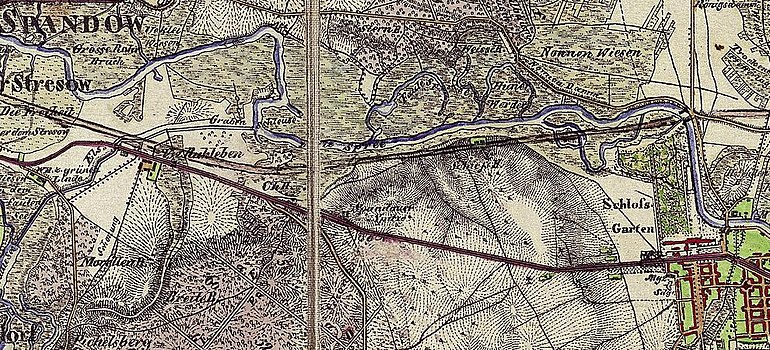
Morellenberge (today: Murellenberge) → Breite Berge (today: Olympic site ) → Murellenteich (no name, today at the settlement of Ruhleben ) → Spandauer Spitze (today : Park Ruhwald ) → Schießhaus (Schützenhaus from 1818, below Fürstenbrunner Höhe, later Spandauer Berg (now "regulated", see above ), at today's Rohrdammbrücke ); further to the east is the Charlottenburg Palace Park . Note: it is possible that the entire area from the Spandauer Spitze to the Schießhaus was later referred to as Fürstenbrunner Höhe and then Spandauer Berg.
literature
- Biotope types and FFH habitat type mapping for the NSG Murellenschlucht and Schanzenwald, NSG Fließwiese Ruhleben and adjacent areas . Client: Senate Department for Urban Development, Planland (Landscape Development Planning Group), Berlin 2006.
- Murellenschlucht and Schanzenwald nature reserve . In: Senate Department for Urban Development Berlin: Berlin of course! Nature conservation and NATURA 2000 areas in Berlin. Verlag Natur & Text, Berlin 2007, ISBN 978-3-9810058-3-7 , pp. 120–123.
- Maintenance and development plan for the nature reserves "Murellenschlucht and Schanzenwald" and "Fließwiese Ruhleben" . Client: Senate Department for Urban Development, Planland (Landscape Development Planning Group), Berlin 2007.
- West Berlin plan work. Goals, strategies and landscape planning model. (PDF; 1.4 MB) Ed .: Senate Department for Urban Development, Kulturbuchverlag, Berlin 2004, ISBN 3-88961-185-0 .
Web links
- Murellenberg, Murellenschlucht, Murellenteich and Schanzenwald . In: District Lexicon Charlottenburg-Wilmersdorf on berlin.de
- The Schanzenwald wakes up from its slumber . Senate Department for Urban Development, October 2007
- Denkzeichen am Murellenberg Homepage of Patricia Pisani on the memorials
References and comments
- ↑ Brandenburg name book. Part 10. The names of the waters of Brandenburg . Founded by Gerhard Schlimpert , edited by Reinhard E. Fischer . Edited by K. Gutschmidt, H. Schmidt, T. Witkowski. Berlin contributions to name research on behalf of the Humanities Center for History and Culture of East Central Europe. V. Verlag Hermann Böhlaus Successor, Weimar 1996, ISBN 3-7400-1001-0 , p. 187 (see reference to the field name Murellenberg in the entry on Morellgraben )
- ^ Klaus Katzer: Berlin's street names. Haude and Spener, Berlin 1982, p. 150. ISBN 3-7759-0256-2
- ↑ Plan work West Berlin. Goals, strategies and landscape planning model . ( Memento of January 7, 2010 in the Internet Archive ) (PDF; 1.4 MB) see literature, graphic on Teltowkante, p. 12, Senate Department for Urban Development
- ^ Pichelsberg . In: District Lexicon Charlottenburg-Wilmersdorf on berlin.de
- ↑ a b c d e f g h i j k l m n nature reserve Murellenschlucht and Schanzenwald . In: Senate Administration [...] (see literature)
- ↑ Ordinance on the Protection of Natural Monuments in Berlin , dated March 2, 1993 (with additions, as of August 2002) (PDF; 734 kB), Senate Department for Urban Development; for both boulders see p. 43
- ^ Hainer Weißpflug: Berlin monuments of nature. A topographical and historical study. Edition Luisenstadt, Berlin 1997, ISBN 3-89542-096-4 , pp. 258f.
- ^ Boulders in Berlin . Ed .: State Office for Nature Conservation and Landscape Management in Berlin, Verlag Ihring, Berlin 1970, p. 10.
- ↑ Forst Grunewald ( Memento from May 15, 2010 in the Internet Archive ) Murellenberg & Murellenschlucht
- ↑ Nature conservation and NATURA 2000 area Fließwiese Ruhleben . In: Senate Department for Urban Development Berlin: Berlin of course! Nature conservation and NATURA 2000 areas in Berlin. Verlag Natur & Text, Berlin 2007, ISBN 978-3-9810058-3-7 , p. 124.
- ↑ Erika Schachinger: Conrad Heidenreich and Paul Michel. The architects of the Huth wine house . In: Mitteilungen des Verein für die Geschichte Berlins , Issue 4, April 1998 diegeschichteberlins.de
- ^ Angela M. Arnold, Gabriele von Griesheim: Trümmer, Bahnen und Bezirke , self-published, Berlin 2002, p. 88, ISBN 3-00-009839-9
- ↑ a b c d e District Office Charlottenburg-Wilmersdorf Kiezspaziergang on May 11, 2002 with Social and Environmental Councilor Martina Schmiedhofer: From the Pichelsberg S-Bahn station through the Murellenschlucht to the Ruhleben U-Bahn station
- ^ GASAG ( Memento from May 3, 2009 in the Internet Archive ) Erdgasspeicher Berlin
- ^ A. Schneider, M. Stark, W. Littmann: Erdgasspeicher Berlin - Methods of operational management. In: Petroleum Gas Coal. Urban-Verlag, Hamburg / Vienna, November 1, 2011, accessed December 30, 2019 .
- ↑ Ruhleben cemetery . In: District Lexicon Charlottenburg-Wilmersdorf on berlin.de
- ↑ a b Elsgrabenweg. In: Street name lexicon of the Luisenstädtischer Bildungsverein (near Kaupert )
- ↑ The Siemensstadt - A Lexicon of Siemensstadt in Berlin ( Memento from July 20, 2012 in the web archive archive.today ) Faule Spree (the drainage function of the Elsgraben specified here for the Nonnenwiesen cannot be correct as the Nonnenwiesen were on the other side of the Spree.)
- ↑ Nature conservation and NATURA 2000 area Fließwiese Ruhleben . In: Senate Department for Urban Development Berlin: Berlin of course! Nature conservation and NATURA 2000 areas in Berlin. Verlag Natur & Text, Berlin 2007, p. 125. ISBN 978-3-9810058-3-7 .
- ↑ Landscape Program , Species Protection Program 1994 (PDF; 2.2 MB) Senate Department for Urban Development and Environmental Protection, pp. 73, 79
- ↑ Geocaching
- ↑ Park Ruhwald . ( Memento from May 30, 2009 in the Internet Archive ) In: Bezirkslexikon Charlottenburg-Wilmersdorf on berlin.de (the spelling Schaefer-Voit instead of Schaeffer-Voit used by the district office is correct in that it is preferred by the publisher himself; mostly, as on written on his tombstone at Luisenfriedhof II , Schaeffer-Voit)
- ↑ Fürstenbrunner Weg. In: Street name lexicon of the Luisenstädtischer Bildungsverein (near Kaupert )
- ↑ Spandauer Berg . In: Street name lexicon of the Luisenstädtischer Bildungsverein
- ^ A b Michael Grube: FTC - Fighting Town Center, Berlin. In: geschichtsspuren.de, September 14, 2004 geschichtsspuren.de
- ↑ Günther Fischer, Arne Hengsbach u. a .: Spandau - A New Prussian fortress. Historical floor plans, plans and views of Spandau . Supplement to sheet 6: Plan von Spandau 1859 , ed. from Citadel Spandau Citizens' Advisory Board, Berlin 1986.
- ↑ Entry in the Berlin State Monument List
- ↑ a b c d Senate Department for Urban Development Ruhlebener Schanzenwald with Murellenberg accessible again , press box, November 28, 2007
- ↑ Birgit Eltzel: Jogging on the shooting range. A city forest has been created from a military training area . In: Berliner Zeitung , November 28, 2007
- ↑ Senate Department for Urban Development The Schanzenwald awakens from its slumber , October 2007
- ↑ a b c Murellenberg, Murellenschlucht, Murellenteich and Schanzenwald . In: District Lexicon Charlottenburg-Wilmersdorf on berlin.de
- ↑ Lexetius Federal Administrative Court, BVerwG, judgment of March 28, 2007 - 9 A 16. 06 (Lexetius.com/2007,1175)
- ↑ News - DB ProjektBau supported renaturation of the Schanzenwald ( Memento from January 31, 2009 in the Internet Archive ) Hiking where the bullets once flew , S-Bahn Berlin , current issues, December 12, 2007
- ↑ Senate Department for Urban Development New Paths on the Havel: "Am Rupenhorn" forest area now open to the public , press box, April 9, 2009
- ↑ Forsten, Havelhöhenweg, Section 1. (PDF; 827 kB) Urban Development Berlin; Havelhöhenweg, path section 1: Stößenseebrücke - Schildhorn "Directly along the water", see p. 2: "Murellenschleife trail"
- ↑ a b memorial at Murellenberg history
- ↑ Murellenschlucht (place the cursor on the 7th circle from the top on the left)
- ^ Stefan Schulz: Staakener Pastor Theile saved human lives . In: Berliner Zeitung , November 28, 2007
- ↑ Claudia Fuchs: The dead from the Murellenschlucht . In: Berliner Zeitung , May 8, 2002.
- ↑ a b c Lothar Eberhardt: illoyal.kampagne.de Second-class commemoration, memorial for Wehrmacht deserters hidden in the forest. ( Memento from December 26th, 2008 in the Internet Archive ) In: disloyal - Journal für Antimilitarismus. No. 20/21, Berlin Autumn 2002, ISSN 1434-2871 .
- ↑ a b Senate Department for Urban Development Competition "Memorial to remember those murdered by the Nazi military justice on Murellenberg" in Berlin-Charlottenburg
- ↑ Denkzeichen am Murellenberg Patricia Pisani: Content considerations on traffic mirrors.
- ↑ Memorial on Murellenberg . Representation by Patricia Pisani
- ↑ Denkzeichen am Murellenberg Patricia Pisani: Spiegeltexte am Denkzeichen
- ↑ Murellenschlucht (place the cursor on the 7th circle from the top on the left); on the Hitler quote and a similar speech by Baumann, see also: AG Peace Research at the University of Kassel : Finally: Memorial stone for the conscientious objectors and deserters of the Wehrmacht in Buchenwald revealed, "In memory of the victims of the National Socialist military justice ..."
- ↑ Carolin Brühl: The police should shoot elsewhere. In: Berliner Morgenpost , June 7, 2002 online
- ^ Hans W. Korfmann: Lothar Eberhardt . In: Kreuzberger Chronik , issue 97, Berlin May 2008
- ↑ Senate Department for Urban Development NSG Murellenschlucht and Schanzenwald, brief description with map of the NSG
- ↑ a b Ordinance on the Murellenschlucht and Schanzenwald nature reserve in the Charlottenburg district of Berlin of March 10, 1993 (PDF; 29 kB) Senate Department for Urban Development
- ↑ Information board in the Murellenschlucht, as of April 2009
- ↑ Christoph Saure: Red list and total species list of bees and wasps (Hymenoptera part.) From Berlin with information on the ants. In: The State Commissioner for Nature Conservation and Landscape Management / Senate Department for Urban Development (ed.): Red lists of endangered plants and animals of Berlin. (PDF; 440 kB) Berlin 2005 (CD-ROM).
- ↑ MLUV Brandenburg ( Memento of March 6, 2007 in the Internet Archive ) (PDF; 58 kB) Red List Water Beetles; Nature conservation and landscape management in Brandenburg 9 (3), 2000
- ↑ Berlin Ornithological Working Group (BOA) ( Memento from March 6, 2005 in the Internet Archive ) Older breeding bird programs
- ↑ Plan work West Berlin. Goals, strategies and landscape planning model . ( Memento of January 7, 2010 in the Internet Archive ) (PDF; 1.4 MB) […] (see literature), pp. 9, 13, 19, 27, 29.

